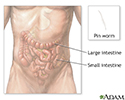Pinworm test
Oxyuriasis test; Enterobiasis test; Tape test
A pinworm test is a method used to identify a pinworm infection. Pinworms are small, thin worms that commonly infect young children, although anyone can be infected.
Pinworm
Pinworms are small worms that infect the intestines.

How the Test is Performed
When a person has a pinworm infection, adult pinworms live in the intestine and colon. At night, the female adult worms deposit their eggs outside the rectum or anal area.
One way to detect pinworms is to shine a flashlight on the anal area. The worms are tiny, white, and threadlike. If none are seen, check for 2 or 3 additional nights.
The best way to diagnose this infection is to do a tape test. The best time to do this is in the morning before bathing, because pinworms lay their eggs at night.
Steps for the test are:
- Firmly press the sticky side of a 1-inch (2.5 centimeters) strip of cellophane tape over the anal area for a few seconds. The eggs stick to the tape.
- The tape is then transferred to a glass slide, sticky side down. Put the piece of tape in a plastic bag and seal the bag.
- Wash your hands well.
- Take the bag to your health care provider. The provider needs to check the tape to see if there are eggs.
The tape test may need to be done on 3 separate days to improve the chances of detecting the eggs.
You may be given a special pinworm test kit. If so, follow instructions on how to use it.
How to Prepare for the Test
No special preparation is necessary.
How the Test will Feel
The skin around the anus may have minor irritation from the tape.
Why the Test is Performed
This test is performed to check for pinworms, which can cause itching in the anal area.
What Abnormal Results Mean
If adult pinworms or eggs are found, the person has a pinworm infection. Usually the whole family needs to be treated with medicine. This is because pinworms are easily passed back and forth between family members.
Risks
There are no risks with this test.
References
Dent AE, Kazura JW. Enterobiasis ( Enterobius vermicularis ). In: Kliegman RM, Stanton BF, St. Geme JW, Schor NF, eds. Nelson Textbook of Pediatrics . 20th ed. Philadelphia, PA: Elsevier; 2016:chap 294.
Maguire JH. Intestinal nematodes (roundworms). In: Bennett JE, Dolin R, Blaser MJ, eds. Mandell, Douglas, and Bennett's Principles and Practice of Infectious Diseases. 8th ed. Philadelphia, PA: Elsevier Saunders; 2015:chap 288.
-
Pinworm eggs - illustration
Pinworms are a common problem in children and may spread to adults (typically the parents or other care-givers). The eggs may be easily seen under a microscope. To obtain a sample, a piece of cellophane tape is pressed against the patient's anal opening. The sticky side of the tape picks up the pinworm eggs and the tape is then stuck to a microscope slide. The eggs can be viewed under the microscope, as seen above. (Image courtesy of the Centers for Disease Control and Prevention.)
Pinworm eggs
illustration
-
Pinworm, close-up of the head - illustration
This is the head of a pinworm. Pinworms are most common in children. They are easily transmitted and sometimes appear in small outbreaks among school children.
Pinworm, close-up of the head
illustration
-
Pinworms - illustration
Pinworms are a contagious intestinal parasite infestation that occurs commonly in children.
Pinworms
illustration
-
Pinworm eggs - illustration
Pinworms are a common problem in children and may spread to adults (typically the parents or other care-givers). The eggs may be easily seen under a microscope. To obtain a sample, a piece of cellophane tape is pressed against the patient's anal opening. The sticky side of the tape picks up the pinworm eggs and the tape is then stuck to a microscope slide. The eggs can be viewed under the microscope, as seen above. (Image courtesy of the Centers for Disease Control and Prevention.)
Pinworm eggs
illustration
-
Pinworm, close-up of the head - illustration
This is the head of a pinworm. Pinworms are most common in children. They are easily transmitted and sometimes appear in small outbreaks among school children.
Pinworm, close-up of the head
illustration
-
Pinworms - illustration
Pinworms are a contagious intestinal parasite infestation that occurs commonly in children.
Pinworms
illustration
Review Date: 7/13/2016
Reviewed By: Linda J. Vorvick, MD, Medical Director and Director of Didactic Curriculum, MEDEX Northwest Division of Physician Assistant Studies, Department of Family Medicine, UW Medicine, School of Medicine, University of Washington, Seattle, WA. Also reviewed by David Zieve, MD, MHA, Isla Ogilvie, PhD, and the A.D.A.M. Editorial team.



